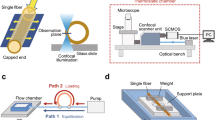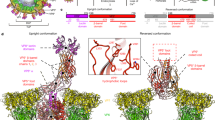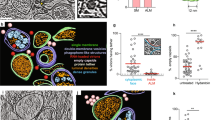Abstract
An attempt was made (1) to correlate permeation properties such as filtration rate, filtration coefficient, and critical filtration volume with filtration conditions of virus contaminated aqueous solutions through porous regenerated cellulose membrane, (2) to demonstrate possibility of complete rejection of viruses from filtrate, (3) to clarify the captured state of viruses in the membrane and the concentration distribution of the captured viruses to the direction of thickness of the membrane, and (4) to propose the mechanism of capturing viruses with the membrane by taking into account the membrane structure and a three-dimensional form of pores (i.e., morphology of pores). Porous regenerated cellulose membrane prepared by the phase separation method consisted of the secondary particles of cellulose, and there exist large cavities and narrow veins connecting these cavities in the membrane. Most of virus particles were trapped either in veins by the blocking or in cavities by the accumulation, but a very few of them flowed downstream and finally contaminated in filtrate. A “critical filtration volume Vc [ml cm−2]” was defined as total filtration volume obtained till the moment when the first virus reached to the opposite (i.e., rear) side of the membrane. Complete rejection of viruses from the filtrate was achieved until total filtration volume reached Vc, which increased with the pressure difference ΔP and concentration of virus in the filtrand c0. Without exceeding its Vc, the porous cellulose membrane will be one of possible membranes designed for the removal of virus from aqueous serum protein mixtures.
Similar content being viewed by others
Log in or create a free account to read this content
Gain free access to this article, as well as selected content from this journal and more on nature.com
or
References
K. Kamide and S. Manabe, in “Material Science of Synthetic Membranes, ACS Symposium Series, No. 269, D. R. Lloyd, Ed., American Chemical Society, Washington, D.C., 1985, pp 197–228.
S. Manabe, Y. Kamata, H. Iijima, and K. Kamide, Polym. J., 19, 391 (1987).
S. Manabe, H. Iijima, and K. Kamide, Polym. J., 20, 307 (1988).
K. Kamide, “Thermodynamics of Polymer Solutions,” A. D. Jenkins, Ed., Elsevier Science Publisher B. V., Amsterdam, The Netherlands, 1990, p 548.
K. Kamide, H. Iijima, and S. Matsuda, Polym. J., 25, 1113 (1993).
K. Kamide, H. Iijima, and H. Shirataki, Polym. J., 26, 21 (1994).
H. Iijima, S. Matsuda, and K. Kamide, Polym. J., 26, 439 (1994).
K. Kamide, H. Iijima, and A. Kataoka, Polym. J., 26, 623 (1994).
H. Iijima, A. Kataoka, and K. Kamide, Polym. J., 27, 1033 (1995).
W. J. Elford, J. Path. Bact., 34, 505 (1931).
J. D. Ferry, Chemical Reviews, 18, 373 (1936).
T. Miyake, T. Shiba, and I. Watanabe, Jpn. J. Microbiol., 11, 203 (1967).
M. Trudel and P. Payment, Can. J. Microbiol., 26, 1334 (1980).
K. Hou, C. P. Gerba, S. M. Goyal, and K. S. Zerda, Appl. Environ. Microbiol., 40, 892 (1980).
J. Steinmann, Appl. Environ. Microbiol., 41, 1043 (1981).
S. Farrah, Appl. Environ. Microbiol., 43, 659 (1982).
S. N. Singh and C. P. Gerba, Appl. Environ. Microbiol., 45, 232 (1983).
D. M. Dziewulski and G. Belfort, Wat. Sci. Tech., 15, 75 (1983).
R. N. Purdy, B. N. Dancer, M. J. Day, and D. J. Stickler, J. Appl. Bacteriol., 58, 231 (1985).
C. Wallis and J. Melnick, J. Virology, 1, 472 (1967).
B. A. Ver, J. L. Melnick, and C. Wallis, Virology, 2, 21 (1968).
Y. Hamamoto, S. Harada, S. Kobayashi, K. Yamaguchi, H. Iijima. S. Manabe, T. Tsurumi, H. Aizawa, and N. Yamanoto, Vox Sang., 56, 230 (1989).
T. Tsurumi, N. Osawa, T. Hirasaki, K. Yamaguchi, S. Manabe, and T. Yamashiki, Polym. J., 22, 304 (1990).
T. Tsurumi, N. Osawa, H. Hitaka, T. Hirasaki. K. Yamaguchi, S. Manabe, and T. Yamashiki, Polym. J., 22, 751 (1990).
Japanese Patent Application, 58-89625 (1983).
Japanese Patent Application, 59-204911 (1984).
“Polymer Handbook, 3rd ed,” J. Brandrup and E. H. Immergut, Ed., John Wiley & Sons, Inc., New York, N.Y., 1989, p V/122.
See, for example, R. E. Kesting, “Synthetic Polymer Membranes,” 2nd ed, John Wiley & Sons, Inc., New York, N.Y., 1985, p 49.
The Microbial World 5th ed,” R. Y. Stanier J. L. Ingraham, M. L. Wheelin, and P. R. Painter, Ed., Prentice-Hall, Englewood Cliffs, N. J., 1986, p 217.
“A Picture Book of Virus,” Y. Hosaka, S. Kawase, and T. Matsui, Ed., Kodansha, Tokyo, Japan, 1972, p 610.
B. Alberts, D. Bray, J. Lewis, M. Raff, K. Roberts, and J. D. Watson, “Molecular Biology of the Cell,” Garland Publishing, Inc., New York, N.Y., 1983, p 233.
See, for example, H. Fraenkel-Conrat and P. C. Kimball, “Virology,” Prentice-Hall, Inc., Englewood Cliffs, N. J., 1982.
See, for example, M. Essex and P. J. Kanki, Scienctific American, October 1988, p 44.
K. Kamide and H. Iijima, in “Cellulosic Polymers, Blends and Composites,” R. D. Gilbert, Ed., Carl Hanser Verlag, New York, N.Y., 1994, p 189.
Author information
Authors and Affiliations
Rights and permissions
About this article
Cite this article
Iijima, H., Sogawa, K. & Kamide, K. Thermodynamics of Formation of Porous Polymeric Membrane by Phase Separation Method VI. Supermolecular Structure and Virus Separability of Porous Regenerated Cellulose Membrane Prepared by Phase Separation Method. Polym J 28, 808–816 (1996). https://doi.org/10.1295/polymj.28.808
Issue date:
DOI: https://doi.org/10.1295/polymj.28.808



